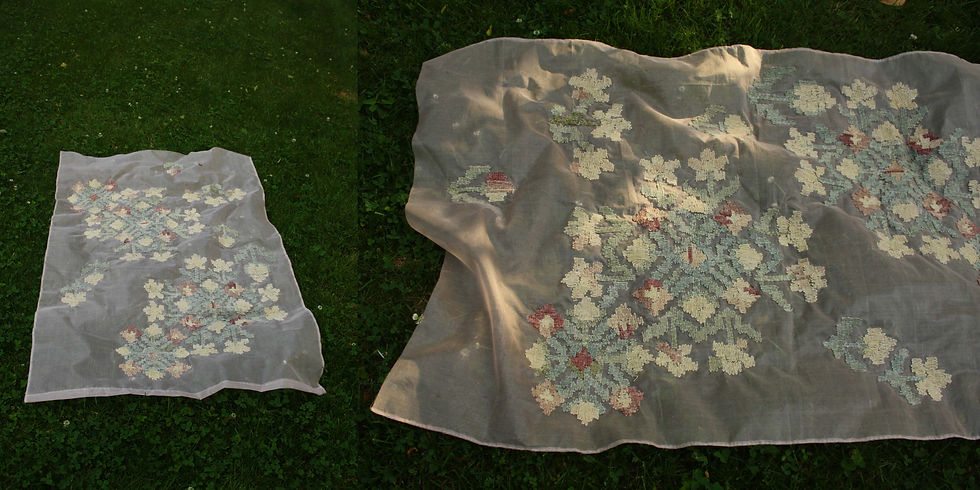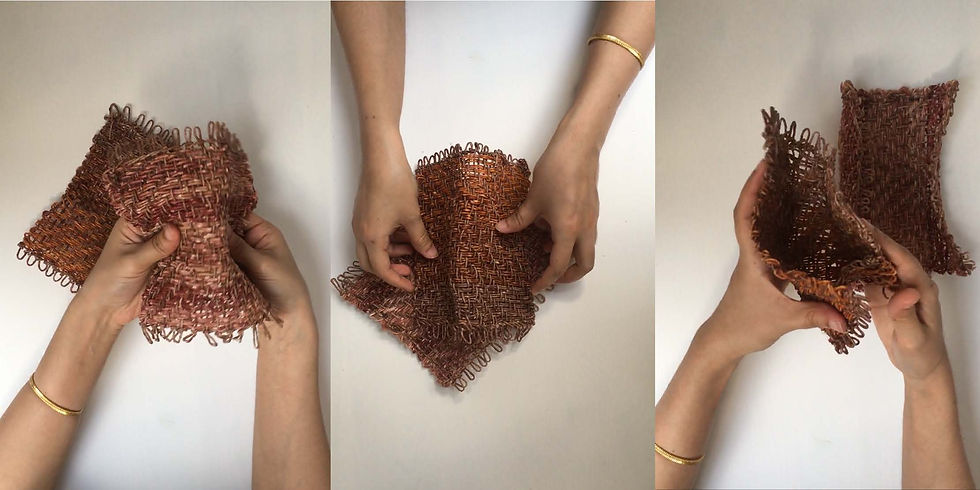REMINISCENT
Reinterpreting the fragrance industry, Reminiscent is an experimental sensorial collection that uses natural ways to integrate and infuse scents into handmade textiles through weaving, embroidery, and fragrant embellishments.
The sense of smell is a powerful catalyst to trigger memories and feelings of calm and comfort. Reminiscent explores the concept of scents for wellness and how fragrances can be expressed visually through color, patterns, and textures. It is a system of using textiles as aromatherapy to condense time and distance and create an immersive experience to reconnect with nature, nostalgia, home, and identity.
Reminiscent is currently on display at the Delaware Contemporary, Wilmington DE as part of the show 'Remembrances, Recollections, and Retrospect' from January 22-May 30, 2022.




Role: designer, artist, material researcher
colorist
Timeline: January 2020 - May 2020
#sustainability #fragrance #sensorialtextiles
#nature #nostalgia #wellbeing
Many of us in urban environments crave the sensorial experience of being amidst nature. We are currently living in a time when we are going to see a rise in the number of people staying indoors. A time when emotional and mental well-being is becoming increasingly necessary and important. Reminiscent allows one to be able to reconnect with nature through scent.


The ubiquitous nature of textiles and its applications is constantly progressing and evolving. We are inspired by the old, be it techniques, patterns, materials etc. and we allow that to impact or influence the future. Textiles seep deep into world history, culture and customs. Our landscapes are constantly evolving and with it the materials available; our craft is transitioning with technology, yet there is a growing necessity of retaining the handmade. Can textiles today also help with well-being? Can it interact with all our senses?
Through a collection of wall hangings, tapestries and room dividers that stimulates the senses beyond sight with a feeling of familiarity, I play with fragrances each bearing a strong connection with my South Indian heritage. By creating a coating for cotton yarn with wax and tree resin, colored with natural pigments and fragranced with oils, I have integrated scent into handwoven and embroidered textiles. I explore patterns and geometry, incorporating recycled sari silk in jeweled tones, fragrant vetiver root, and organza silk naturally dyed in earth hues.
12” x 32”
dyed cotton and chenille double weave with
pockets of dried lavender and peppermint


_Page_03.jpg)
| Flower market, Malleshwaram, Bangalore 2019 |
_Page_05.jpg)
_Page_03.jpg)
| My grandmother’s dressing table, Bangalore, 2019 |
_Page_06.jpg)
| My grandmother's dresser, Bangalore, 2020 |
| Spices in the kitchen, Bangalore, 2020 |
I use only natural and biodegradable materials in my work and no harmful chemicals. I coat cotton yarn with filtered beeswax, a tree-based resin, natural pigments to provide colour and pure essential oils for fragrance. The yarn is cured for 24-48 hours before it is embroidered onto the naturally dyed silk fabrics.
_Page_07.jpg)
I use techniques of embroidery and weaving to integrate scent into textiles. My practice involves using natural ways to introduce the scent, working primarily with fragrant materials and coated yarn. The coating is wax-based combined with tree resin, pure essential oils, and colored with natural dyes and earth pigments.

_Page_09.jpg)
The sweet familiar fragrance of home, memories and celebration. The jasmine flower,
reminiscent of South India, brings to mind thoughts of visits to flower markets, of weddings and
celebrations, of garlands worn in women’s hair, and of the buds blooming in our gardens.
It is one of my favorite scents. I play with transparency, light, distortion and pattern to elevate
the delicate, feminine, airy aesthetics of its scent and its memories.
13.jpg)

Jasmine I
52" x 34"
Embroidery
Silk, jasmine-scented
cotton dyed with beetroot, indigo, and turmeric



Textiles for Aroma Therapy
Scented room dividers and curtains that create a soothing and calming ambiance and can be used in spaces for healing and wellness.

Jasmine II
41” x 44”
Un dyed silk organza, jasmine buds
|Accessible pockets to replace buds|

_Page_14.jpg)

_Page_15.jpg)
The overwhelming smell of roses at the flower market that evokes feelings of love,
happiness and passion. Rose garlands that adorn our deities at temples, the exchange
of garlands between the bride and groom at weddings and the sweet smelling
rose bush in my parents terrace garden.
17.jpg)



Roses in Bloom : A series of natural dye experiments
Embroidery
Rose-scented yarn, organza silk dyed with combinations of Rojo Quebracho, safflower, red sandalwood, and iron,

Rose
Handwoven
Pre-dyed handspun recycled sari silk and rose
scented wax beads dyed with beetroot, hibiscus, chili and cutch
19.jpg)
Rose II
30” x 22”

Rose
13.5" x 11"
Handwoven
Pre-dyed hand-spun recycled sari silk and rose-scented wax beads dyed with beetroot, hibiscus, chili, and cutch


_Page_23.jpg)
Pungent, lemony and slightly sweet. I associate this fragrance with my school days, the citronella candles we lit on our terrace on humid summer evenings and the carefree times at summer camp, where we doused ourselves with odomos bug repellant to keep the mosquitoes away.
20.jpg)

Citronella I
39" x 15.5"
Handwoven
Pre-dyed cotton and citronella scented yarn dyed with turmeric, indigo, and chili


Citronella II
35" x 16"
Handwoven
Pre-dyed cotton, recycled sari silk, and citronella scented yarn dyed with turmeric, indigo and chili

_Page_27.jpg)
23.jpg)

_Page_29.jpg)
The layered, grounding, woody scent of the first rains hitting the parched summer earth. The roots of vetiver, a perennial bunch grass native to India, releases a complex aroma and a natural cooling effect when activated with water. Bringing Vetiver into urban spaces by taming its wildness through embroidery and weaves and introducing a sense of delicateness, fragility
and dimension.
24.jpg)


Vetiver I, Vetiver II
44”; x 20"; 32" x 20"
Handwoven
Pre dyed cotton, vetiver root, vetiver scented wax beads dyed with cutch, turmeric, chilli
_Page_34.jpg)

Vetiver II
32” x 20”
Hand woven cotton, vetiver root, vetiver scented wax beads dyed with cutch, tumeric, chili


25.jpg)
Vetiver III
20” x 14”
Handwoven
Handspun recycled sari silk with vetiver scented wax beads dyed with cutch, turmeric, and chili





_Page_38.jpg)
Vetiver IV
18” x 24”
Embroidery
Vetiver root, pre-dyed mercerized cotton





Vetiver V
36" x 50"
Embroidery
Vetiver root, pre-dyed mercerized cotton
_Page_40.jpg)
Sandalwood smells like a musky, powdery and creamy wood. It brings to mind my grandmother’s dressing table and the smell of Mysore sandal soap and talcum powder that fills the air in her room when she steps out of the shower.
.jpg)

Sandalwood
15” x 13.5”
Embroidery
Sandalwood scented yarn dyed with cutch and beetroot, organza silk dyed with cutch, rojo quebracho, walnut, madder and iron

Scented Textile Wall Coverings
Fragrant and naturally dyed wallpaper/coverings
that envelop you in your favorite scent
_Page_46.jpg)
The sweet and spicy scent of cloves reminds me of the spice rack in our kitchen at home, the tempering of our curries, the chewing of clove during a toothache. This fragrance is reminiscent of home and the holidays.
29.jpg)

.jpg)
Handwoven
Clove scented yarn dyed with beetroot, hibiscus, cutch and chilli

Clove
Handwoven
Clove scented yarn dyed with beetroot, hibiscus, cutch, and chilli

_Page_48.jpg)
Natural fibers especially protein-based fibers like silk and wool are often prone
to moth infestations that can cause
damage to precious and expensive
fabrics. Scents such as clove, rosemary
and lavender are natural pest repellants. Inspired by the ritual of keeping cloves
in cupboards to preserve silk saris,
scented woven casings/wrappings to store fabrics can be used to help preserve such textiles and keep moths at bay.

Reminiscent at Mana Contemporary, Jersey City, NJ



Natural dyes and extracts can produce an infinite range of colors. Each recipe produces a different shade, intensity and saturation. A sprinkle of iron as a modifier can completely change a tomato red to a burnt rust or a lime yellow to an olive green. The beauty lies in not knowing what to expect and the surprise is left to nature as the collaborator.

Rose tint natural dye experiments

Sketches for citronella

Natural dyes and extracts can produce an infinite range of colors. Each recipe produces a different shade, intensity and saturation. A sprinkle of iron as a modifier can completely change a tomato red to a burnt rust or a lime yellow to an olive green. The beauty lies in not knowing what to expect and the surprise is left to nature as the collaborator.
Navigate arrows to view photos of process
Scroll and click to view other work














